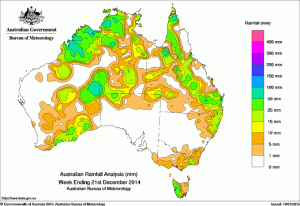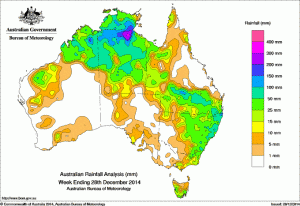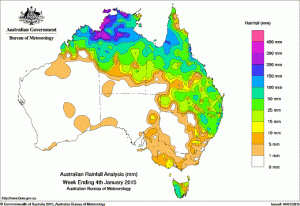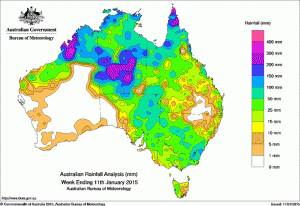The long-awaited sight of rain gauges brimming with water and the cacophony of frogs croaking across muddy, rain soaked paddocks returned to large areas of inland Australia over the Christmas/New Year period.
However, while positive for many, the storm activity was also typically patchy in nature, leaving many drought-affected properties still desperately waiting for some seasonal relief.
There are hopes that some of those remaining gaps may be filled later this week as low pressure activity in the Coral Sea develops into what could be the first tropical cyclones of the season.
Over the New Year period a monsoon trough delivered the Top End its wettest start to a year in two decades.
Central Australia was pounded by torrential rain over the weekend, representing the heaviest falls of rain around Alice Springs for 15 years.
Further south the South Australian township of Karoonda in the Mallee recorded 69mm in three days, that town’s wettest start to summer in three years.
Some areas of Queensland have also enjoyed relief, however several severely droughted areas such as Richmond, Cloncurry, Longreach, St George and Dirranbandi have again been left disappointed.
Parts of New South Wales received their heaviest falls for more than a decade over the weekend when a broad low pressure trough created a rainband across the state, with the exception of far northern parts.
The biggest totals were recorded in the State’s far west, where Fowlers Gap collected a whopping 112mm in the 24 hours to 9am yesterday, the best rain in more than a decade. Burrinjuck Dam recorded 54mm, its heaviest January total in two decades.
Tibooburra picked up 26mm, almost double the January average.
Some regions of Victoria have also exceeded average January rainfall totals.
In Queensland, home to around half of Australia’s beef cattle herd, summer rainfall has been very hit and miss, with reported totals within most districts typically varying from downpours of several inches to falls that barely settled the dust.
“It is really typical storm weather, it is starting to fill the gaps in, but there are a lot of big gaps still there,” Grant Daniel Long managing director Peter Daniel told Beef Central.
“There are still water issues as well.
“All round there has been some good relief but a lot of areas have still missed out.”
One plus for drought affected cattle producers however is the positive state of cattle prices.
“The market is so positive and there are good outlets for those that have missed out,” Mr Daniel said.
“Those that have to sell have somewhere to go, whereas prior to three months ago those that had to sell had no where to go.”
Queensland’s drought-stricken north has received some relief but remains well short of a fundamental seasonal break.
Luke Westaway at TopX Richmond said many areas had a received a start with falls of one to three inches, but were yet to receive the follow up needed to get grass growing.
“It has got everyone out of trouble for the moment,” Mr Westaway said, adding that many properties were still hanging on by tooth and nail after successive failed wet seasons.




